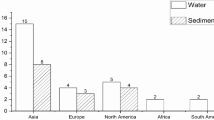Abstract
A sensitive and specific technique is described for the estimation of phycobiliprotein in freshwater and marine picophytoplankton. The method uses fluorescent properties to detect phycoerythrin concentrations as low as 40 ng L-1 from a 1 L water sample and is capable of distinguishing between R-phycoerythrin, C-phycocyanin and C-phycoerythrin. The application of the method to the study of natural picophytoplankton populations in marine and freshwater environments is described. Nitrate concentrations appear to influence picophytoplankton cellular C-phycoerythrin concentrations in surface waters and increasing cellular C-phycoerythrin fluorescence with water depth suggests that this pigment plays a role as a photosynthetic accessory pigment.
Similar content being viewed by others
References
Alberte RS, Wood MA, Kursar TA, Guillard RRL (1984) Novel phycoerythrins in marine Synechococcusspp. Characterisation and evolutionary and ecological implications. Pl. Physiol. 75: 732-739.
Algarra P, Estrada M, Niell FX (1988) Phycobiliprotein distribution across the western Mediterranean divergence. Deep Sea Res. 35: 1425-1430.
Butcher RW (1952) Contributions to our knowledge of the smaller marine algae. J mar. Biol. Ass. U.K. 31: 175-191.
Bryant DA, Glazer AN, Eiserling FA (1976) Characterisation and structural properties of the major biliproteins of Anabaenasp. Arch. Microbiol. 110: 113-127.
Carr NG, Whitton BA (1973) Biology of the Blue-Green Algae, Botanical Monographs No 9. Blackwell Scientific, Oxford, 673 pp.
Downes MT (1992) The separation of phycobilin pigments by high performance liquid chromatography. Taupo research Laboratory Report 139, Division of marine and freshwater Science, Department of scientific and industrial Research, Wellington, 14 pp.
Ernst A, Sandeman G, Postius C, Brass S, Kenter U, Böger P (1992) Cyanobacterial picoplankton from lake Constance. II Classification of isolates by cell morphology and pigment composition. Bot. Acta 105: 161-167.
Glazer AN, Bryant DA (1975) Allophycocyanin B (λmax 671, 618 nm). A new cyanobacterial phycobiliprotein. Arch. Microbiol. 104: 15-22.
Glover HE (1985) The physiology and ecology of the marine cyanobacteria genus Synechococcus. Adv. aquat. Microbiol. 3: 49-107.
Hall JA (1991) Long term preservation of picoplankton for counting by fluorescence microscopy. Br. phycol. J. 26: 169-174.
Johnson PW, Sieburth JMcN (1979) Chroococoid cyanobacteria in the sea: a ubiquitous and diverse phototrophic biomass. Limnol. Oceanogr. 24: 928-935.
O'Carra P, O'hEocha C (1976) Algal biliproteins and phycobilins. In Goodwin TW (ed.) Chemistry and Biochemistry of Plant Pigments, Academic Press, London, 270 pp.
O'hEocha C, O'Carra P (1961) Spectral studies of denatured phycoerythrin. J. Am chem. Soc. 83: 1091-1093.
Olson RJ, Frankel SL, Chisholm SW, Shapiro HM (1983) An inexpensive flow cytometer for the analysis of fluorescence signals in phytoplankton: chlorophyll and DNA distributions. J exp. mar. Biol. Ecol. 68: 129-144.
Stockner JG, Antia NJ (1986) Algal picoplankton from marine and freshwater ecosystems: a multidisciplinary perspective. Can. J. Fish. aquat. Sci. 43: 2472-2503.
Waterbury JB, Watson SW, Guillard RRL, Brand LE (1979) Widespread occurrence of a unicellular, marine, plankton, cyanobacterium. Nature 277: 293-294.
Waterbury JB, Watson SW, Valois FW, Franks DG (1986) Biological and ecological characterisation of the marine unicellular bacterium Synechococcus. In Platt T, Lee WKW (eds) Photosynthetic Picoplankton. Can. Bull. Fish. aquat. Sci. 214: 71-120.
Wood AM, Horan PK, Muirhead K, Phinney DA, Yentsch CM, Waterbury JB (1985) Discrimination between types of pigments in marine Synechococcusspp. by scanning spectroscopy, epifluorescence microscopy and flow cytometry. Limnol. Oceanogr. 30: 1303-1305.
Wyman M, Gregory, RPF, Carr, NG (1985) Novel role for phycoerythrin in a marine cyanobacterium, Synechococcusstrain DC2. Science 230: 818-820.
Yentsch CM, Horan PK, Muirhead K, Dortch Q, Haugen E, Legendre L, Murphy LS, Perry MJ, Phinney DA, Pomponi SA, Spinrad RW, Wood M, Yentsch CS, Zahuranec BJ (1983) Flow cytometry and cell sorting: a technique for analysis and sorting of aquatic particles. Limnol. Oceanogr. 28: 1275-1280.
Author information
Authors and Affiliations
Rights and permissions
About this article
Cite this article
Downes, M.T., Hall, J.A. A sensitive fluorometric technique for the measurement of phycobilin pigments and its application to the study of marine and freshwater picophytoplankton in oligotrophic environments. Journal of Applied Phycology 10, 357–363 (1998). https://doi.org/10.1023/A:1008085719486
Issue Date:
DOI: https://doi.org/10.1023/A:1008085719486




